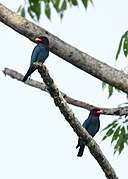Oriental dollarbird
The Oriental dollarbird (Eurystomus orientalis) is a bird of the roller family, so named because of the distinctive blue coin-shaped spots on its wings. It can be found from Australia to Korea, Japan and India.
| Oriental dollarbird | |
|---|---|
| Adult | |
| Scientific classification | |
| Kingdom: | Animalia |
| Phylum: | Chordata |
| Class: | Aves |
| Order: | Coraciiformes |
| Family: | Coraciidae |
| Genus: | Eurystomus |
| Species: | E. orientalis |
| Binomial name | |
| Eurystomus orientalis (Linnaeus, 1766) | |
 | |
| Distribution of the oriental dollarbird | |
| Synonyms | |
|
Coracias orientalis Linnaeus, 1766 | |
Taxonomy and systematics
The oriental dollarbird was originally described in the genus Coracias. Formerly, some authorities have also considered the broad-billed roller and the azure dollarbird to have been subspecies of the oriental dollarbird. Alternate names for the oriental dollarbird include the Asian dollarbird, dark roller, dollar roller, dollarbird, eastern broad-billed roller and oriental broad-billed roller.
Subspecies

Ten subspecies are recognized:[2]
- E. o. cyanocollis - Vieillot, 1819: Found from the Himalayas through China to south-eastern Siberia, Korea and Japan
- E. o. orientalis - (Linnaeus, 1766): Found from the southern Himalayas to Indochina, the Malay Peninsula, Sumatra, Java, Borneo and the Philippines
- E. o. laetior - Sharpe, 1890: Found in south-western India
- E. o. gigas - Stresemann, 1913: Found on southern Andaman Islands
- E. o. irisi - Deraniyagala, 1951: Found in Sri Lanka
- E. o. oberholseri - Junge, 1936: Found on Simeulue (off north-western Sumatra)
- Australian roller (E. o. pacificus) - (Latham, 1801): Originally described as a separate species in the genus Coracias. Found on the Lesser Sunda Islands, northern and eastern Australia
- E. o. waigiouensis - Elliot, DG, 1871: Originally described as a separate species. Found on New Guinea, western Papuan islands, D'Entrecasteaux Islands and the Louisiade Archipelago
- E. o. crassirostris - Sclater, PL, 1869: Originally described as a separate species. Found in the Bismarck Archipelago
- E. o. solomonensis - Sharpe, 1890: Originally described as a separate species. Found in the Solomon Islands
Description
The oriental dollarbird has a length of up to 30 cm. It is dark brown but this is heavily washed with a bluish-green sheen on the back and wing coverts. Its belly and undertail coverts are light coloured, and it has glossy bright blue colouring on its throat and undertail. Its flight feathers are a darker blue. Its bill is short and wide and in mature animals is coloured orange-red with a black tip. It has very light blue patches on the outer parts of its wings which are highly visible in flight and for which it is named. The females are slightly duller than the males but overall the two are very similar. Immature birds are much duller than the adults and do not have the blue colouring on their throats. They also have brown bills and feet instead of the red of the adults.[3]
Distribution and habitat
The oriental dollarbird is found from Australia to Japan and India. It breeds in northern and eastern Australia between the months of September and April and winters in New Guinea and nearby islands. The birds prefer open wooded areas with hollow-bearing trees to build nests in.
Behaviour and ecology
The oriental dollarbird is most commonly seen singly with a distinctive upright silhouette on a bare branch high in a tree, from which it hawks for insects, returning to the same perch after a few seconds.

Gallery
_at_Jayanti%2C_Duars%2C_West_Bengal_W_Picture_060.jpg)
_at_Jayanti%2C_Duars%2C_West_Bengal_W_Picture_059.jpg) Jayanti in Buxa Tiger Reserve in Jalpaiguri district of West Bengal, India.
Jayanti in Buxa Tiger Reserve in Jalpaiguri district of West Bengal, India. Singing at Miami MetroZoo, USA
Singing at Miami MetroZoo, USA Kaeng Krachan Nat’l Park - Thailand
Kaeng Krachan Nat’l Park - Thailand
References
- BirdLife International (2016). "Eurystomus orientalis". IUCN Red List of Threatened Species. 2016: e.T22682920A92968881. doi:10.2305/IUCN.UK.2016-3.RLTS.T22682920A92968881.en.
- "IOC World Bird List 7.1". IOC World Bird List Datasets. doi:10.14344/ioc.ml.7.1.
- http://www.birdsinbackyards.net/species/Eurystomus-orientalis
Further reading
- Higgins, Peter J., ed. (1999). "Eurystomus orientalis Dollarbird" (PDF). Handbook of Australian, New Zealand and Antarctic Birds. Volume 4: Parrots to dollarbird. Melbourne: Oxford University Press. pp. 1225–1239. ISBN 978-0-19-553071-1.
External links
![]()
